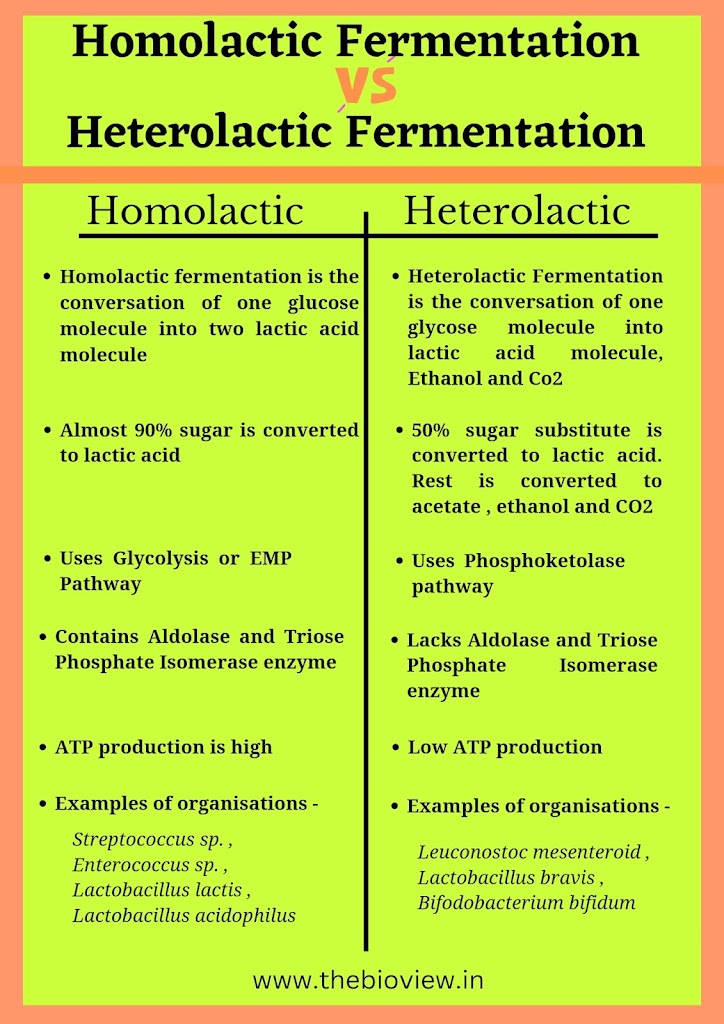The key difference between Homolactic and Heterolactic Fermentation is the formation of different products in these fermentation Pathways. In homolactic Fermentation one glucose molecule is converted into two lactic acid molecules but incase of Heterolactic Fermentation a single glucose molecule is converted into lactic acid , carbon dioxide, Ethanol and also Acetic acid.
What is Fermentation?
The anaerobic process by which energy is released even in the absence of Oxygen from Glucose (hexose sugar molecule), is called Fermentation. Mainly Yeast and bacteria ferment glucose. But it can also be seen in animal muscle cells. A net of maximum 2 ATP is generated in the fermentation process.
What is Lactic Acid Fermentation ?
The main product of this type of fermentation is Lactic acid. This process is carried out by LAB (Lactic acid bacteria). These LAB organisms are the gram positive (+ve) bacilli, which is further divided into two groups (Homolactic and Heterolactic) on the basis of their fermentative product formation.
What is Homolactic Fermentation?
- Lactic acid is the sole fermentative product of the Homolactic Fermentation process.
- These groups of bacteria ferment Glucose as their one and only carbon source.
- This type of fermentative bacteria have the enzyme Aldolase that breaks down Fructose 1,6-bisphosphate to Glyceraldehyde-3-phosphate and DHAP (Dihydroxyacetone phosphate)
- Homolactic Fermentation is carried out by Streptococcus sp , Enterococcus sp and various species of Lactobacillus like Lactobacillus lactis and Lactobacillus acidophilus etc.
Read More about Difference between mitochondrial DNA and Chloroplast DNA
What is Heterolactic Fermentation?
- Ethanol, CO2 and Acetic acid are produced along with lactic acid.
- Heterolactic fermentative bacterium lack Aldolase and Triose Phosphate Isomerase which are the key enzymes of Glycolysis Pathway.
- They use Phosphoketolase pathway for oxidising Glucose-6-phosphate and then decarboxylated Ribulose-6-phsophate, which is then converted into Xylulose-5-phosphate and then to Glyceraldehyde-3-phosphate and acetyl phosphate by enzyme Phosphoketolase.
- Example of Heterolactic fermentative bacterium are Leuconostoc mesenteroids , Lactobacillus bravis etc.
Key Differences between Homolactic and Heterolactic Fermentation
- A single product is formed in Homolactic Fermentation whereas incase of Heterolactic Fermentation multiple products are formed.
- In homolactic fermentation almost 90% of sugar substitute is converted to lactic acid but on the other hand only 50% of sugar is converted to lactic acid and the rest is converted to CO2 and Ethanol.
- Homolactic Fermentation uses EMP Pathway (Emben Mayerhoff Paranas) for decomposition of hexose but Heterolactic fermentative microbes use Phosphoketolase Pathway.
- Aldolase and Triose Phosphate Isomerase enzymes are present in Homolactic Fermentation but Heterolactic Fermentation lacks those enzymes.
- Higher number of ATP is produced in homolactic fermentation.
Homolactic Fermentation vs Heterolactic fermentation in tubular infographic form
Summary: Homolactic vs Heterolactic Fermentation
The main differences observed in the fermentation product of two subgroups of lactic acid fermentation are determined by the presence or absence of the enzyme Aldolase, the key enzyme involved in Glycolysis. For the absence of Aldolase, more than one product is formed in Heterolactic Fermentation



Very detailed article this helps a lot in writing notes on homolactic and heterolactic fermentation.